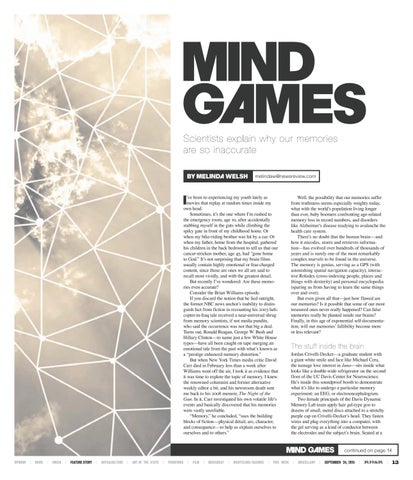Scientists explain why our memories are so inaccurate melindaw@newsreview.com
I
’ve been re-experiencing my youth lately as movies that replay at random times inside my own head. Sometimes, it’s the one where I’m rushed to the emergency room, age 10, after accidentally stabbing myself in the guts while climbing the spiky gate in front of my childhood home. Or when my bike-riding brother was hit by a car. Or when my father, home from the hospital, gathered his children in the back bedroom to tell us that our cancer-stricken mother, age 45, had “gone home to God.” It’s not surprising that my brain films usually contain highly emotional or fear-charged content, since those are ones we all are said to recall most vividly, and with the greatest detail. But recently I’ve wondered: Are these memories even accurate? Consider the Brian Williams episode. If you discard the notion that he lied outright, the former NBC news anchor’s inability to distinguish fact from fiction in recounting his 2003 helicopter-in-Iraq tale received a near-universal shrug from memory scientists, if not media pundits, who said the occurrence was not that big a deal. Turns out, Ronald Reagan, George W. Bush and Hillary Clinton—to name just a few White House types—have all been caught on tape merging an emotional tale from the past with what’s known as a “prestige enhanced memory distortion.” But when New York Times media critic David Carr died in February less than a week after Williams went off the air, I took it as evidence that it was time to explore the topic of memory. I knew the renowned columnist and former alternative weekly editor a bit, and his newsroom death sent me back to his 2008 memoir, The Night of the Gun. In it, Carr investigated his own volatile life’s events and basically discovered that his memories were vastly unreliable. “Memory,” he concluded, “uses the building blocks of fiction—physical detail, arc, character, and consequence—to help us explain ourselves to ourselves and to others.”
Well, the possibility that our memories suffer from truthiness seems especially weighty today, what with the world’s population living longer than ever, baby boomers confronting age-related memory loss in record numbers, and disorders like Alzheimer’s disease readying to avalanche the health care system. There’s no doubt that the human brain—and how it encodes, stores and retrieves information—has evolved over hundreds of thousands of years and is surely one of the most remarkably complex marvels to be found in the universe. The memory is genius, serving as a GPS (with astonishing spatial navigation capacity), interactive Rolodex (cross-indexing people, places and things with dexterity) and personal encyclopedia (sparing us from having to learn the same things over and over). But even given all that—just how flawed are our memories? Is it possible that some of our most treasured ones never really happened? Can false memories really be planted inside our brains? Finally, in this age of exponential self-documentation, will our memories’ fallibility become more or less relevant?
The stuff inside the brain Jordan Crivelli-Decker—a graduate student with a giant white smile and face like Michael Cera, the teenage love interest in Juno—sits inside what looks like a double-wide refrigerator on the second floor of the UC Davis Center for Neuroscience. He’s inside this soundproof booth to demonstrate what it’s like to undergo a particular memory experiment: an EEG, or electroencephalogram. Two female principals of the Davis Dynamic Memory Lab team apply hair gel-type goo to dozens of small, metal discs attached to a stretchy purple cap on Crivelli-Decker’s head. They fasten wires and plug everything into a computer, with the gel serving as a kind of conductor between the electrodes and the subject’s brain. Seated at a
continued on page 14 OPINION
|
NEWS
|
GREEN
|
FEATURE STORY
|
ARTS&CULTURE
|
ART OF THE STATE
|
FOODFINDS
|
FILM
|
MUSICBEAT
|
NIGHTCLUBS/CASINOS
|
THIS WEEK
|
MISCELLANY
|
SEPTEMBER 24, 2015
|
RN&R
|
13









